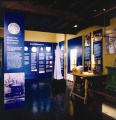Difference between revisions of "Category:Intangible heritage"
m (Blanked the page) |
(intro done) |
||
| Line 1: | Line 1: | ||
| + | UNESCO defines the intangible culture as practices, representations, expressions, knowledge, skills that communities recognize as part of their cultural heritage. This intangible cultural heritage, transmitted from generation to generation, is constantly recreated by communities and groups in response to their environment, their interaction with nature and their history, and provides them with a sense of identity and continuity, thus promoting respect for cultural diversity and human creativity. | ||
| + | In Slovenia it is usually divided in the following areas: | ||
| + | * oral traditions and folk literature (e.g. [[2 Reels - Association for Reanimation of Storytelling|storytelling]]) | ||
| + | * performances and presentations (theatre e.g. [[Škofja Loka Passion Play]], singing, instrumental music) | ||
| + | * customs and habits (seasonal customs e.g. [[Kurentovanje]] or [[Mardi Gras at Cerknica]]) | ||
| + | * knowledge and practices concerning the environment | ||
| + | * traditional craftsmanship (e.g. [[Lace Festival, Idrija|lacemaking from Idrija]]) | ||
| + | * cultural environment | ||
| + | |||
| + | Its safeguarding is based on the UNESCO Convention (2003) and the state law on natural and cultural heritage (2008). It has been coordinated by [[Institute of Slovene Ethnology]] and will be eventually enlisted in [[Register of Slovene cultural heritage - rkd.situla.org|the national register]]. This list, however, provides you with some of the ongoing intangible cultural events as well as with the main institutional contacts for your convenience. | ||
| + | |||
| + | [[Category:Heritage]] | ||
Revision as of 22:40, 2 April 2010
UNESCO defines the intangible culture as practices, representations, expressions, knowledge, skills that communities recognize as part of their cultural heritage. This intangible cultural heritage, transmitted from generation to generation, is constantly recreated by communities and groups in response to their environment, their interaction with nature and their history, and provides them with a sense of identity and continuity, thus promoting respect for cultural diversity and human creativity.
In Slovenia it is usually divided in the following areas:
- oral traditions and folk literature (e.g. storytelling)
- performances and presentations (theatre e.g. Škofja Loka Passion Play, singing, instrumental music)
- customs and habits (seasonal customs e.g. Kurentovanje or Mardi Gras at Cerknica)
- knowledge and practices concerning the environment
- traditional craftsmanship (e.g. lacemaking from Idrija)
- cultural environment
Its safeguarding is based on the UNESCO Convention (2003) and the state law on natural and cultural heritage (2008). It has been coordinated by Institute of Slovene Ethnology and will be eventually enlisted in the national register. This list, however, provides you with some of the ongoing intangible cultural events as well as with the main institutional contacts for your convenience.
Articles in category "Intangible heritage"
The following 34 pages are in this category, out of 34 total.
D
I
S
Media in category "Intangible heritage"
The following 48 files are in this category, out of 48 total.
- 0M8A5639.jpg 721 × 1,024; 143 KB
- 0M8A5811.jpg 1,280 × 853; 126 KB
- 11.2.2023 Otvoritvena etno povorka Stanko Kozel-299.jpg 1,024 × 682; 123 KB
- 11.2.2023 Otvoritvena etno povorka Stanko Kozel-329.jpg 1,024 × 682; 108 KB
- 21.-2.-2023 Predaja-oblasti-in-pokop-pusta Stanko-Kozel-43.jpg 1,280 × 853; 117 KB
- 21.-2.-2023 Predaja-oblasti-in-pokop-pusta Stanko-Kozel-48.jpg 1,280 × 853; 158 KB
- Cerkno Museum 2008 Permanent exhibition Photo Tomaz Lauko (2).jpg 4,352 × 3,264; 2.19 MB
- Cerkno Museum 2008 Permanent exhibition Photo Tomaz Lauko (3).jpg 4,352 × 3,264; 3.44 MB
- Cerkno Museum 2008 Permanent exhibition Photo Tomaz Lauko (4).jpg 4,352 × 3,264; 2 MB
- Cerkno Museum 2008 Permanent exhibition Photo Tomaz Lauko.jpg 4,352 × 3,264; 3.03 MB
- DSC06942.jpg 1,280 × 821; 179 KB
- DSC09482.jpg 1,280 × 853; 111 KB
- DSC09660.jpg 1,280 × 853; 181 KB
- Hudič Stanko Kozel 2023.jpg 2,376 × 1,584; 1.32 MB
- Idrija Lace Festival 2005 Idrija lace.jpg 1,972 × 1,944; 884 KB
- Idrija Lace Festival 2007 Contemporary fashion design exhibition Photo Jani Peternelj.jpg 3,687 × 1,844; 2.88 MB
- Idrija Lace Festival 2007 Footwear design by Ana Novak Photo Jani Peternelj.jpg 2,592 × 3,872; 487 KB
- Idrija Lace Festival 2007 Installation Photo Jani Peternelj (2).jpg 2,008 × 3,000; 3.81 MB
- Idrija Lace Festival 2007 Installation Photo Jani Peternelj.jpg 3,872 × 2,592; 664 KB
- Idrija Lace Festival 2008 replica of tablecloth Photo Jani Peternelj.jpg 3,872 × 2,592; 4.51 MB
- Idrija Lace Festival demonstration by students Photo Jani Peternelj.jpg 3,331 × 2,230; 4.94 MB
- Kurenti koranti Stanko Kozel 2023 N.jpg 1,800 × 1,200; 1.03 MB
- Lipica Stud Farm 2004 Pastures.jpg 1,280 × 960; 488 KB
- Lipica Stud Farm 2005 Lipizzaner horses.jpg 2,448 × 3,264; 5.01 MB
- Lipica Stud Farm 2008 Classical Riding School Photo Dalibor Gregor.jpg 3,008 × 2,000; 2.97 MB
- Lipica Stud Farm 2008 Classical Riding School Photo Patrick Dome.jpg 2,912 × 4,368; 4.22 MB
- Lipica Stud Farm 2011 Lipizzaner horses.jpg 4,288 × 2,848; 2.92 MB
- Ljutomer Trotter Museum 2014 trotter.jpg 2,677 × 2,009; 3.16 MB
- Loka Museum 1998 permanent exhibition.jpg 1,696 × 1,757; 2.79 MB
- Museum of Salt Making Secovlje 2020 Entrance Photo Kaja Brezocnik.jpg 2,048 × 1,365; 1,011 KB
- Museum of Salt Making Secovlje 2020 Exterior Photo Kaja Brezocnik (1).jpg 2,048 × 1,365; 840 KB
- Museum of Salt Making Secovlje 2020 Exterior Photo Kaja Brezocnik (2).jpg 2,048 × 1,365; 906 KB
- Museum of Salt Making Secovlje 2020 Exterior Photo Kaja Brezocnik (3).jpg 2,048 × 1,365; 868 KB
- Museum of Salt Making Secovlje 2020 Exterior Photo Kaja Brezocnik (4).jpg 2,048 × 1,365; 1.02 MB
- Museum of Salt Making Secovlje 2020 Secovlje Regional Park Photo Kaja Brezocnik (1).jpg 2,048 × 1,365; 1.28 MB
- Museum of Salt Making Secovlje 2020 Secovlje Regional Park Photo Kaja Brezocnik (2).jpg 2,048 × 1,365; 610 KB
- Museum of Salt Making Secovlje 2020 Secovlje Regional Park Photo Kaja Brezocnik (3).jpg 2,048 × 1,365; 945 KB
- Museum of Salt Making Secovlje 2020 Secovlje Regional Park Photo Kaja Brezocnik (4).jpg 2,048 × 1,365; 894 KB
- Museum of Salt Making Secovlje 2020 Secovlje Regional Park Photo Kaja Brezocnik (5).jpg 2,048 × 1,365; 824 KB
- Museum of Salt Making Secovlje 2020 Secovlje Regional Park Photo Kaja Brezocnik (6).jpg 2,048 × 1,365; 1.18 MB
- Museum of Salt Making Secovlje 2020 Secovlje Regional Park Photo Kaja Brezocnik (7).jpg 2,048 × 1,370; 1.01 MB
- Museum of Salt Making Secovlje 2020 Secovlje Regional Park Photo Kaja Brezocnik (8).jpg 2,048 × 1,365; 727 KB
- National competition in lacemaking at the Idrija Lace Festival - Photo Jani Peternelj.jpg 3,331 × 2,230; 3.87 MB
- Obhodi kurentov Stanko Kozel 2023.jpg 2,120 × 1,342; 1.04 MB
- Orači 2023 Stanko Kozel Mednarodna.jpg 6,000 × 4,000; 4.25 MB
- Ptujski prstan Kurentovanje 2023 Stanko Kozel (9).jpg 2,048 × 1,366; 1.14 MB
- Pustna ringarajanja Stanko Kozel 2023.jpg 1,901 × 1,267; 712 KB
- Vile 11.2.2023 Otvoritvena etno povorka 2023 Stanko Kozel final.jpg 3,000 × 2,000; 1.21 MB


















































